Content
Blackberries are a tasty and healthy berry that is very popular in private gardening. Many land owners dream of seeing dark purple fruits in their beds, containing many vitamins and trace elements. The task is not that difficult, provided that the “right” varieties are selected for cultivation. In this article, you will find out which blackberries are the best.
Short description
Blackberries began to be cultivated in the United States in the 19th century. Most of the species were bred there, in natural conditions. At the moment, there are about 300 varieties. This diversity is explained by the fact that plants easily interbreed with each other, showing the world more and more new hybrids.
Blackberry is a perennial shrub most often covered with thorns. Depending on how the stems grow, a distinction is made between kumanika (erect branches) and dewdrop (creeping branches). Leaves are complex. Flowers - self-pollinated, large, collected in a brush. The fruit is a drupe.
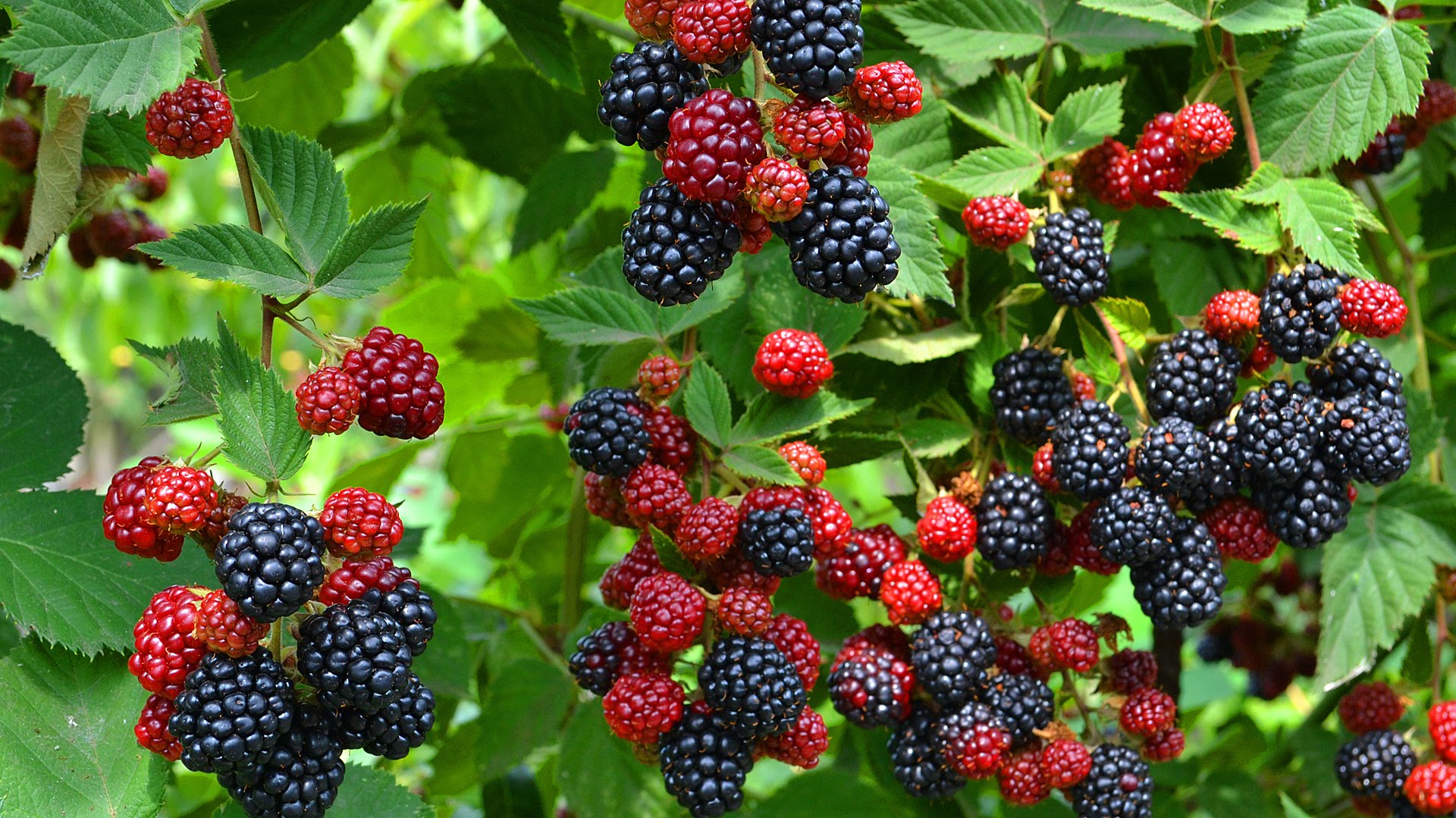
Berries contain iron, calcium, potassium, manganese, phosphorus, organic acids, vitamins C, A, K, PP, fiber, amino acids. Blackberries have antipyretic, anti-inflammatory, anti-edematous and bactericidal effects. It normalizes blood pressure, calms the nervous system, removes toxins, and speeds up metabolism.
Blackberry teas and decoctions are prescribed for obesity, neurosis, constipation, diabetes mellitus, liver and bladder diseases.
The best varieties of blackberries
As you can see, there are enough reasons to grow blackberries in your beds. Now let's choose varieties that are guaranteed to take root and give a stable harvest.
Agave
This variety was bred almost 100 years ago. A thorny bush with erect stems reaches a height of 2 meters. The thorns are long and curved, which makes harvesting difficult. One of the main benefits of blackberries is their resistance to low temperatures. It perfectly tolerates temperatures up to -30 degrees.
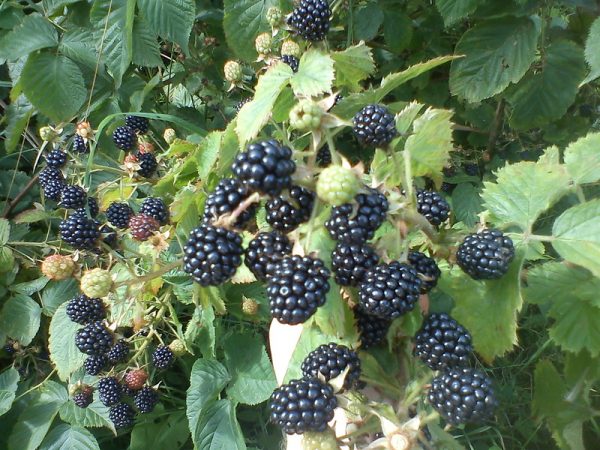
The berries are medium in size, black, with a characteristic shine. The taste is sweet and sour. Blackberries ripen in August-September. From one bush, you can get 10 kg of fruit. The plant takes root without any problems. Moreover, if you do not regularly remove new shoots, Agaves will take up the whole garden.
Doyle
The result of the efforts of foreign breeders is recognized as one of the most productive in the world. In this regard, it is listed in the Guinness Book of Records. The large number of berries is explained by the fact that the plant forms many lateral branches (about 50 cm long) with countless fruits. A significant plus of the variety is the absence of thorns.
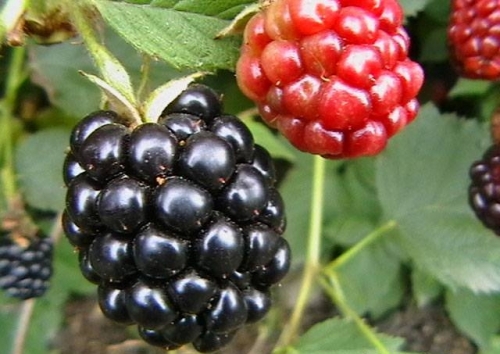
Black fruits are juicy and large. Weight - up to 5 grams. The shape is elongated. The taste is sweet and sour, very pleasant. They tolerate transportation well. Blackberries are frost and drought resistant. Rarely sick. The fruiting period lasts from July to September.
Apaches
Obtained after lengthy experiments on crossing the Navajo variety and the "test" one for that period, sample Ark.1007. The result exceeded all expectations. Large conical black berries retain their original size throughout the season, do not flow or wrinkle during transportation.The taste is sweet, with a pleasant sourish flavor.

The yield is average. From one bush - 7-8 kg of berries. The fruits are harvested from June to August. The plant can withstand temperatures up to -20 degrees, if the thermometer drops below - it requires shelter. Doesn't like drought. In the hot period, the bush must be often watered and shaded with nets or agrofibre.
Black Satin
The variety was bred in 1974. The name was not chosen by chance - the breeders wanted to emphasize the tenderness and silkiness. A semi-shrub with powerful branches, after reaching a certain height, bends to the ground. Shoots sometimes grow up to 5 meters, so they need reliable support.

The berries are large. Weight varies from 5 to 8 grams. Collected in spectacular black tiered brushes. Ripe blackberries are sweet and soft. Wrinkles quickly during transportation. Yield indicators are high. Under favorable conditions, 14-17 kg of fruits are harvested from one bush. It is recommended to harvest immediately after ripening. If this is not done, the blackberries will shrink and crumble.
Karaka Black
The result of multiple crossing of different varieties of raspberries and blackberries. The main advantage of this thorny variety is the fruit. They look unusual - large (10 gr.) Oblong berries taper at the end. The surface is shiny. The taste is memorable, sweet with pleasant sourness. Due to their high density, blackberries can be stored and transported for a long time without losing their commercial qualities.
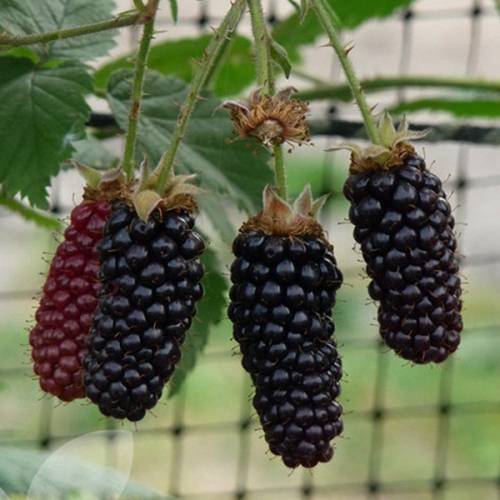
The disadvantage of Karak Black is sharp thorns. Wear thick gloves when handling the bush. One plant produces from 8 to 10 kg of fruits. Harvested from June to August. The variety does not tolerate cold well - protect it from frost, but it is resistant to pests and diseases. Sometimes the leaves begin to turn yellow - this is not a cause for concern, but a distinctive feature of the variety.
Ruben
It appeared not so long ago - in 2011. He immediately won the favor of gardeners. The shrub is short and compact. The branches are flexible, do not break even under strong wind gusts, without thorns. The variety tolerates low temperatures well - you do not need to cover for the winter. Fruiting lasts until the first frost.

The berries are large (4-5 cm long), sweet. They do not lose their original appearance during transportation. From one bush, you can get 14-15 kg of fruit. Ruben is good because it provides an opportunity to feast on delicious blackberries, when everything has been collected from the bushes of other varieties for a long time.
Thornfree
This variety is the dream of any summer resident. Unpretentious to the surrounding conditions, easy to care for, resistant to frost and disease. It grows in one place for a long time - about 30 years. Bred in the USA in 1966. It is very popular to this day.

The main advantages are the absence of thorns, amicable ripening of berries, high decorative qualities of the bush, multi-berry brushes. One plant produces up to 12 kg of fruits. The berries are dark blue, juicy. The taste changes as it ripens: first - sour, then - sweet and sour, after full ripening - freshly sweet. Fruiting occurs in August.
Loch Tay
A thornless variety with large fruits. The plant is tall, erect. Shoots - powerful, resilient, in need of support. The variety is prized for its drought tolerance, good yield and extraordinary taste. The berries are elongated, black, with a glossy surface. A dry sepal signals maturity; in unripe blackberries, it is green.
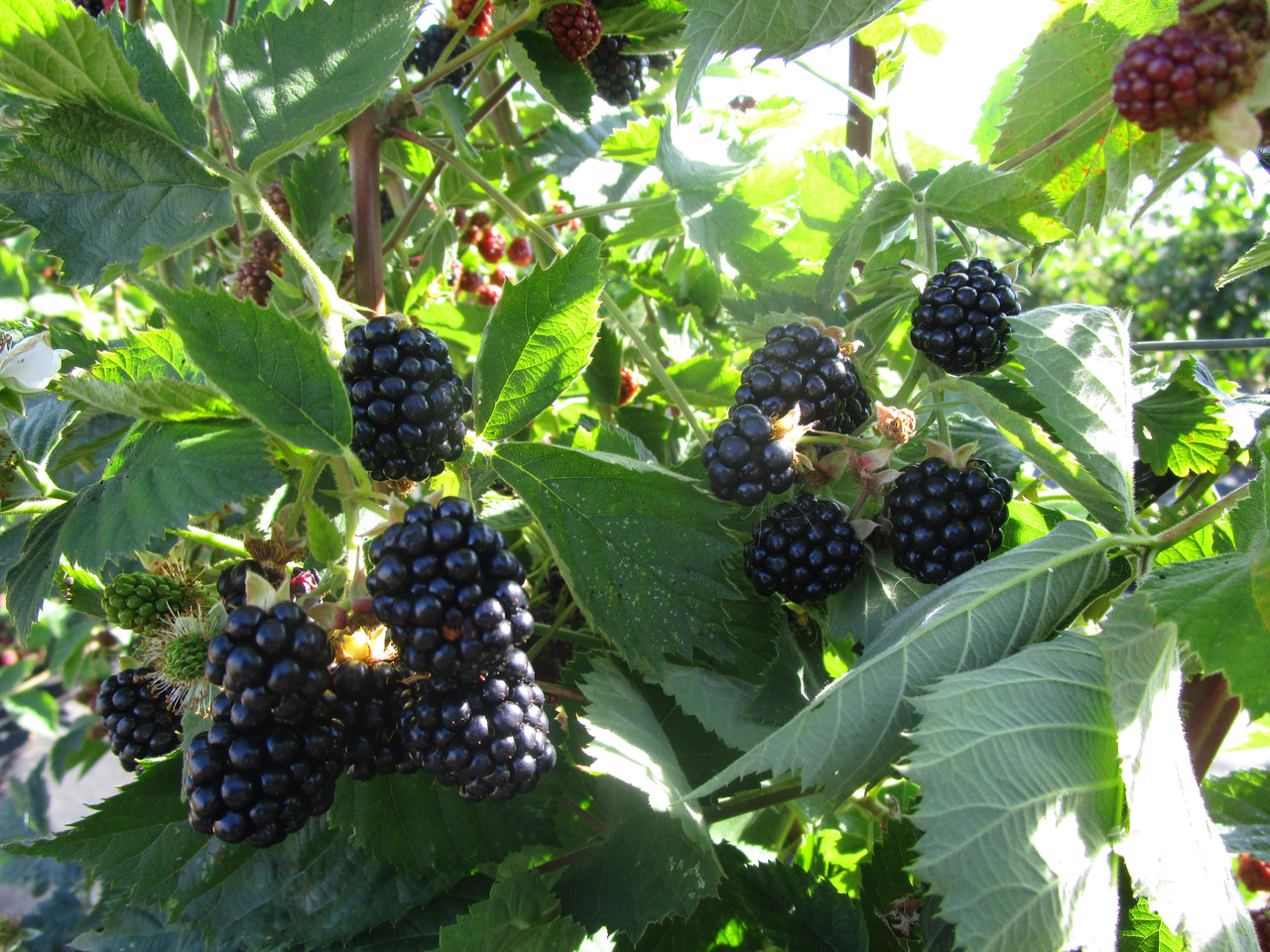
Fruits are homogeneous in structure, dense, do not crumple during collection and transportation. They taste harmonious, rich, sweet, with a pronounced fruity aroma. Blackberries ripen in July. Berries can be picked either manually or mechanically.
Arapaho
Somehow the experts set themselves the goal of creating a strong, upright thornless variety characterized by early ripening. This is how Arapaho appeared. Many people fell in love with blackberries, because they combined the advantages of long-known species.

Fruits are short, conical, dark black in color. The taste is also excellent.Many people call this variety the best in terms of aroma and taste. The plant tolerates a drop in temperature to -25 degrees well and in most cases hibernates without shelter. The berries mainly appear on the side branches. In this regard, it is recommended to pinch the upper shoots, which stimulates their growth.
Polar
This blackberry attracts with good yields with minimal physical costs. The variety was bred in Poland in 2008. Experts have been working on its appearance for over 30 years. Straight shoots without thorns reach a height of 2.5 meters or more.
The glossy black berries have a neat oval shape. The taste is amazing, very pleasant and sweet, without the usual astringency. From one bush, about 7 kg of fruits are obtained.
Polar is distinguished by early ripening and long-term fruiting. Harvesting is possible from July to September. The plant retains its inherent characteristics even after long haul. Disease and pest resistant.
Osage
The hottest new product to date. A patent for this variety has not yet been obtained and there is very little information about it. It is known to be a thornless shrub with straight stems. Easily withstands temperatures down to -13 degrees. Disease resistant.

Berries have great industrial potential due to their adaptability to long-term transportation and storage. Fruits are round in shape, weighing 5 g. As for taste, when creating this variety, John Clarke said: "I dream of developing a variety that I would like to eat without stopping, even a whole bucket." It looks like he succeeded.
Here are 10 of the best blackberry varieties, distinguished by high yields, amazing taste, resistance to low temperatures and pests. Choosing one of them, you cannot go wrong, because you will get the opportunity to enjoy delicious berries throughout the whole summer and even half of autumn.
Video tips for growing blackberries
In recent years, more and more gardeners have begun to plant blackberries on their plots. Despite the fact that this culture is relatively new for us, nurseries offer a large selection of seedlings. The choice is so large that it is easy for an unprepared person to get confused. To prevent this from happening, we will now try to figure out what types of blackberries are and what is their difference.
On this page, the most promising and demanded varieties of this plant are selected, with a description of each variety, photographs and brief planting recommendations.
Depending on the structure of the bush, these plants are conventionally divided into:
- Kumaniks are more like raspberries. The stems of older varieties are thorny, grow upward and require support. They reproduce, like raspberries, by root suckers. Kumanik winter hardiness is high, but most still need shelter for the winter.
- Rosyaniki - similar to a wild blackberry with long creeping shoots. There are varieties with thorny shoots, and there are no thorns at all. It is also grown on trellises. Propagated by dropping shoots. The yield is higher and the berry taste is usually better than that of kumanik. Frost resistance is low, it is necessary to cover for the winter.
Blackberries, like raspberries, have a two-year development cycle: in the first year, the shoots grow, lay fruit buds, the next year they bear fruit and after harvesting they are cut out. The exceptions are remontant blackberry varieties that bear fruit on both young and last year's shoots.
In most of our country, winters are quite harsh and in this regard, most gardeners are interested in frost-resistant plants. Thornless varieties and remontant blackberry varieties are in great demand. They all have their pros and cons.
Frost-resistant blackberry varieties for the Moscow region and the middle zone
Blackberry variety Agavam
Agave
Agave Is an old and very frost-resistant blackberry variety. It is even included in the State Register of varieties recommended for cultivation in the Russian Federation. It can be grown not only in the Moscow region, but also in Siberia.
- Productivity 3 - 6 kg. sometimes up to 10 kg. from one bush
- Berries weigh 3 - 5 grams, sweet taste, ripen in July - August.
- Fruiting lasts at least 15 years
- Shoots are erect, powerful, rigid with sharp thorns, 2.5 - 3 meters high
- Withstands frosts down to -40º, no shelter required for the winter
Advantages of the variety: beautiful flowering, stable fruiting, no need to cover for the winter, drought-resistant and shade-tolerant, grows on any soil and is generally very unpretentious.
Flaws: thorny shoots cause a lot of inconvenience, gives a lot of growth.
In the south, Agaves can be grown both in the shade and in the sun. In the northern regions, berries in the shade may not have time to ripen, so planting in the sun is recommended. When planting, the root collar deepens a few centimeters. The distance between the bushes is 1 meter, between the rows 1.8 - 2 meters. Although the shoots are strong, it is better to tie them up with a fan to the trellises.
Reviews - very controversial. There are ardent supporters of this variety, but there are also ardent opponents who complain that Agavam shoots have filled the entire garden.
Blackberry Polar
Polar
Polar - frost-resistant, thornless, early, large-fruited garden blackberry of Polish selection.
- Productivity 5 - 6 kg. berries from each bush (when wintering without shelter)
- The berries are very large, 10-12 g, sweet, in the southern regions they begin to sing in early July.
- Withstands frosts down to -30º shelter is not necessary. But most gardeners note that if the bushes are covered for the winter, the yield increases several times. From this it follows that the fruit buds still freeze slightly and the shelter will not be superfluous at all.
- Stems are erect, up to 2.5 m, strong, without thorns. They can break when bent to the ground. To facilitate the task, it is necessary to start tilting the shoots in advance, until they are lignified.
Advantages of the variety: frost resistance, large and tasty berries, thornless shoots, disease resistance, early ripening of the crop, good transportability.
Flaws: perhaps only one - it is difficult to bend the shoots to the ground for the winter.
Prefers to grow in the sun, on drained loamy soils. Dislikes damp, waterlogged places.
Reviews: only positive.
Unfortunately, the choice of frost-resistant blackberry varieties is not great. Only Agavam and Polar can winter without shelter, but it is better to cover Polar for the winter. All other varieties of this plant require mandatory shelter.
New thornless blackberry varieties
Currently, surprisingly productive varieties of kumanik and dewdrop have appeared on the market. From one bush, you can collect 2 - 3 buckets of healthy and tasty berries. The mass of these berries is so great that buyers in the market refuse to take them, thinking that they are stuffed with all kinds of chemicals. After reading the description of these varieties, you will understand that this is not an exaggeration.
Natchez
Natchez
Natchez - early ripe, very large-fruited, thornless blackberry variety.
- Productivity up to 20 kg from each bush
- The berries are very large, weighing 10 - 12 grams. sweet taste, begin to sing in June. Fruiting lasts 35 - 40 days
- Semi-erect bushes, shoots up to three meters long.
- For the winter, a cover with agrofibre is required, which is removed only after the soil thaws and the buds swell. If the bush is opened earlier, then the shoots may dry out and the plant will die. This rule also applies to other varieties of blackberries.
- When planting, you must maintain a distance between bushes 3 and between rows 2 meters
Advantages: high yield, large-fruited, early ripening, good keeping quality and transportability of berries, extended fruiting period
Flaws: low winter hardiness, a small number of replacement shoots.
Reviews: The reviews are very good, with a little controversy about Natchez's taste. The fruits of this blackberry variety have a sweet taste, but there is a slight bitterness in it, some do not like it, others believe that it is the bitterness that gives such a unique and refined taste to these berries, and many did not feel bitterness at all.
Ouachita
Ouachita
Ouachita - thornless, large-fruited blackberries of early ripening
- The declared yield of this variety reaches 30 kg. from every bush
- Large berries 6 - 7 gr. and with a very original taste, they begin to ripen in June. Fruiting is extended and lasts almost two months.
- Bushes are powerful erect, shoots grow up to 2.5 - 3 meters. Grown on a trellis, usually with three rows of wire.
- For the winter, the plant must be covered.
- When planting in a bush method, the distance between blackberry seedlings is 1.5 - 2 meters.
Advantages: a very extended ripening period, amazing productivity, disease resistance, berries with an original taste do not lose their marketable qualities for a long time.
Flaws: weak frost resistance -17º, the need to bend down rather thick shoots.
The proposed video is in English, but it clearly shows what kind of crop can be harvested from this plant. By the way, Ouachita, Auchita, Ouachita and Ouachita are the names of the same total variety, the description of which you just read.
Reviews positive - the variety is easy to grow, not capricious. Farmers love the combination of high yields and moderately large berries with great flavor.
Chester
Chester
Chester is an old, well-known, thornless, large-fruited late-ripening blackberry.
- The declared yield is 15 - 20 kg. from every bush
- The berries are sweet with a slight sourness, weighing from 5 to 8 grams, ripen in late July or early August.
- The plant has a semi-sheathing bush shape. No more than 5 - 6 shoots are left for fruiting, which grow 2 - 3 meters long.
- Despite the frost resistance down to -26 ° C, shelter is required for the winter period.
- When planting, it is necessary to maintain a distance between the bushes of 2 - 2.5 meters.
Advantages: high frost resistance, absence of thorny thorns, excellent yield, good transportability of berries, the variety is resistant to major diseases and pests.
Flaws: despite good frost resistance, winter shelter is required. Poorly tolerates shading and planting in damp lowlands.
Reviews: only positive, many consider Chester to be the best variety in their collection and allocate the best places for it.
Black Satin
Black Satin
Black Satin - as well as Chester, a rather old variety of thornless garden blackberry, medium ripening.
- The average yield is 10 - 15 kg, and with high agricultural technology up to 20 - 25 kg.
- Berries weighing about 5 grams, collected in large clusters. Taste from sweet - sour to sweet, ripen in mid - late July.
- Bushes are semi-creeping. Stems are tough, up to 5 meters long. Young shoots are recommended to be immediately pressed to the ground and grown in an inclined position, then it will be easier to cover for the winter.
- Frost resistance - 22 ° C and winter shelter is required in most regions.
- For cultivation, you will need a trellis with a height of about two meters.
Advantages of the variety: lack of thorny thorns, high productivity, unpretentiousness, resistance to diseases.
Flaws: the need to cover for the winter every year, tough shoots that often break when bending to the ground, poor transportability of berries.
Reviews: generally positive, generous, unpretentious variety, winters well under cover. But the berries are overripe quickly, you can not be late with the collection. For commercial purposes, not the best option.
Loch Tei
Loch Tei
Loch Tei - large-fruited, non-prickly blackberry of medium ripening.
- The declared yield is 10 - 12 kg. from every bush. Most gardeners claim that this is the case.
- The berries are large, weighing about 5 grams. The taste is sweet with sourness, ripening in mid-July.
- Loch Tei has a semi-sheathing bush shape. Shoots are vigorous, resilient, up to 5 meters long, requiring trellis.
- The frost resistance of this variety of blackberries is 20 ° C. It is not enough for our country, we have to cover it for the winter.
- When planting, the distance between the bushes is at least 2 m.
- Propagated by dropping the tops of the replacement shoots.
Advantages: good yield, lack of thorny thorns, excellent berry taste and excellent transportability.
Flaws: the need to cover the plant for wintering every year.
Reviews: According to most gardeners, Loch Tei is one of the best varieties of garden blackberries.
Kiova
Kiova
Kiova - blackberries with the largest berries. Unfortunately this variety has sharp thorns, but it is included in the description due to its exceptional large size.
- The yield of Kiova exceeds 30 kg. berries from one bush.
- Huge berries weigh 20 - 25 grams. They start singing at the end of July.
- The bush is erect, the height of the shoots is 1.6 - 2 meters, they require support.
- This blackberry tolerates frosts up to -23 degrees without loss. Without shelter, it can winter only in the southern regions.
Advantages: very productive variety, surprisingly large and tasty berries, good transportability, the ability to surprise neighbors.
Flaws: the presence of sharp thorns, the need to cover the bushes annually for the winter.
All reviews something like this: when I cover the bushes for the winter, I swear that I am suffering with these thorns for the last time, and when I start harvesting, I understand that this blackberry will always grow with me.
Columbia Star
Columbia Star
Columbia Star - a new, little-known, thornless variety of early ripening blackberries.
- According to the manufacturer, Columbia Star will be one of the most productive varieties (16750 kg / ha)
- Berries of the same size, elongated, weighing 10-15 grams, begin to ripen in late June - early July.
- Creeping type bushes, shoots 4 - 5 meters long, without thorns.
- Columbia's winter hardiness is low - 14 degrees, winter shelter is required.
Advantages: tasty, large berries retain their presentation for a long time, high yield, rather soft and thornless shoots are easy to press to the ground for winter shelter. The variety easily tolerates heat and drought.
Flaws: long shoots, with many lateral processes, can be difficult to untangle when removed from a support.
Reviews: gardeners who managed to plant Columbia have not yet been able to fully appreciate this variety, but everyone notes the high taste of the berries. It is considered by many to be the most promising new product.
Chachanska Bestrna
Chachanska Bestrna
Chachanska Bestrna - a high-yielding, thornless variety of early ripening blackberries.
- Productivity 12 - 15 kg. berries from one bush.
- Sweet and sour berries weighing 9-14 grams, begin to ripen in early July.
- Semi-creeping bushes, powerful shoots without thorns, grow up to 3 - 3.5 meters. A garter to the supports is required.
- The frost resistance of the variety is relatively high -26º, but it still has to be covered.
Unfortunately, the video is not of high quality, but this is all that we could find:
Advantages: high productivity, drought resistance, unpretentiousness, immunity to major diseases.
Flaws: poor transportability, ripe berries every other day - another begins to flow. True, for amateur gardening, this disadvantage is not very important.
Reviews: all the reviews are good, this variety has proven itself well in the southern and northern regions.
Doyle
Doyle
Doyle - one of the best varieties of thornless blackberries. It claims to be the most productive variety.
- Doyle's documented yield is 5-7 buckets of berries per bush.
- Berries are sweet and sour, weighing 7 - 9 grams. Ripens later - mid-August.
- Semi-erect bushes with long, up to 5 - 6 m shoots, no thorns. Trellis required for growing
- It is necessary to cover for the winter.
Advantages: amazing productivity, easily tolerates heat and drought.
Flaws: this blackberry is more suitable for the southern regions, in the northern regions it may not have time to ripen.
Reviews: there are very few reviews, in Russia this variety has been cultivated for only a few years.
Waldo
Valdo
Waldo Is an old and proven, thornless, creeping blackberry variety of medium early ripening.
- The authors of the variety promise a yield of 15 - 17 kg. berries from one bush.
- Berries weighing 6 - 8 grams. have a pleasant taste and aroma, they begin to sing in the first decade of July.
- Creeping bushes, compact. The length of the shoots does not exceed 2 meters, but support is needed.
- Average winter hardiness, winter shelter for this blackberry is required.
Advantages: no thorns, easy to cover for the winter, ideal for small areas.
Flaws: in hot weather, berries can be baked.
Loch Ness ‘Loch Ness’
Loch Ness
Loch Ness - thornless, very productive blackberry, medium late ripening.
- The yield of this variety can reach 25 kg. from every bush.
- The berries are sweet, with sourness, similar to the taste of wild blackberries 5 - 8 gr. They begin to ripen at the end of July.
- Loch Ness bushes are vigorous, semi-sheathing. Stems up to 4 meters long, need support.
- Winter hardiness for our climate is not high enough, the bushes have to be covered in winter.
- When planting, the distance between the bushes is at least 2 meters.
Advantages: consistently high productivity, unpretentious in care, quickly and easily multiplies, suitable for commercial use.
Flaws: ripens late, in a rainy summer the taste becomes sour.
Reviews: unequivocally good - with minimal maintenance, always an excellent harvest.
Oregon Thornless
Oregon Thornless
Oregon Thornless - thornless, creeping blackberry of late ripening.
- Average yield, about 10 kg. berries from each bush.
- Berries are sweet and sour, large, weighing 7 - 9 grams, ripen in August.
- The plant forms creeping bushes with thornless shoots up to 4 meters long. Trellis required for cultivation.
- Oregon can withstand temperatures down to -29 degrees, which is clearly not enough for the middle zone and cannot be done without shelter.
Advantages of the variety: excellent taste, the absence of thorny thorns, easy to cover for the winter, the decorativeness of the plant allows you to use it for decorating gazebos, arches and other buildings.
Reviews: "I have this variety in my favorites - the most problem-free - it winters well (under cover), replacement shoots appear immediately, almost simultaneously with the start of fruit shoots growth, the size of the berry with sufficient watering is really large, sweet taste, very fruitful."
Osage
Osage
Osage - thornless blackberry with ideal taste. This variety is considered the most delicious of all blackberry varieties.
- The yield is relatively low, 3 kg. berries from each bush.
- Berries with a perfectly balanced taste and a weight of 6 - 7 grams. begin to sing in the first decade of July.
- Bushes are erect, shoots without thorns, about 2 meters high.
- Low frost resistance, only -13º, shelter is required.
Advantages: exquisite, dessert taste, the sweetest of all varieties of blackberries, never sets the teeth on edge.
Flaws: low winter hardiness and relatively low productivity.
Description of remontant blackberry varieties
Repaired blackberry varieties can be grown for one crop or two. In the first case, all the shoots are cut to the root in the fall and a completely empty bed is in the winter. In the spring, young shoots begin to grow from the roots at the end of August, berries begin to sing on them.
To get two full-fledged harvests next year, only last year's shoots are cut in the fall, and the young are bent to the ground, covered and allowed into the winter. In June next year, berries begin to sing on these shoots. At the end of July, having collected the entire crop, these shoots are cut out. And already at the end of August, young shoots that have grown over the summer begin to bear fruit. Thus, you feast on blackberries for almost the entire summer season.
Unfortunately, all this pleasure is available only to residents of the southern regions. In the northern regions, remontant blackberry varieties do not justify themselves.It is not uncommon for some of the berries to die from frost. The first crop (partially or completely) may die during the flowering stage from recurrent frosts. The second will begin to sing only at the end of August, or even at the beginning of September. The berries simply do not have time to ripen and part of the harvest goes under the snow.
Freedom
Freedom
Prime-Ark Freedom Is a studless, remontant blackberry variety.
- The authors of the variety promise high yields. The variety is new and there are no exact numbers yet.
- The berries are sweet, large, weighing 15 - 20 grams, the first harvest begins to sing from mid-June, and the second in the third decade of August.
- Bushes are erect, medium-sized, stems without thorns about 2 meters high.
- Shelter is required for the winter.
- Propagated by root shoots and cuttings.
Advantages: high productivity, excellent quality of fruits and excellent taste, the ability to receive products throughout the summer.
Flaws: low winter hardiness, the variety is recommended only for the southern regions, the need to bend down and cover the shoots for the winter.
Photo taken from the forum: Black Magic (Black Magic)
Black Magic
Black Magic (Black Magic) - remontant blackberry variety (stems with thorns)
- Productivity from 5 kg. from one bush.
- The berries are sweet, weigh an average of 7 - 10 grams. Ripening terms - the end of June, the first harvest and the last decade of August, the second harvest.
- Shoots are strong, about 1.5 meters high, there are relatively few thorns.
- Weak winter hardiness -12º, winter shelter is required.
Advantages: this variety is best adapted to the climatic conditions of our country. Excellent fruit quality, High productivity, tolerates heat and drought well.
Flaws: thorny shoots, low frost resistance, strong shoots are difficult to press to the ground.
Reuben
Ruben
Reuben - remontant, large-fruited variety of garden blackberry (with thorns)
- Productivity from 6 kg. from one bush.
- The fruits are sweet, large, with an average weight of about 10 grams. Ripen in late June and late August.
- Shoots are erect, medium-sized with thorns.
- The plant can withstand a drop in temperature down to -16º, a shelter is required.
Dignity: variety resistant to frost, tolerates shading well, excellent transportability of berries.
Flaws: the main disadvantage is the sterilization of pollen already at + 30º
Prime-Ark 45
Prime Arc 45
Prime-Ark 45 - a new remontant blackberry variety (with thorns).
- Producers promise good yields, but no specific data yet.
- Berries are transportable, sweet taste and weighing 6 - 8 grams.
- Bushes are erect, with a moderate number of thorns. They tolerate heat and drought well.
- It does not hibernate without shelter.
Traveller - Prime-Ark Traveler
Traveller
Traveller - Prime-Ark Traveler - new, studless remontant blackberry.
- This variety is still little studied, but the Americans claim that productivity will be at its best.
- Berry weight 7 - 8 gr. The taste is sweet and sour.
- Bushes are erect, about two meters high, without thorns
- When grown for two harvests, the shoots are bent to the ground in the fall and covered with spunbond in 2 - 3 layers.
Save article to:
Dear visitors of the "Dacha Plot", tireless gardeners, gardeners and flower growers. We offer you to pass the aptitude test and find out if you can trust the shovel and let you into the garden with it.
Test - "What kind of summer resident I am"
Share this article with your friends:
Is it possible to successfully cultivate this berry here, which comes from distant America? Quite, if you grow the best varieties of blackberries in the country, adapted to our climate. They began to grow blackberries in garden culture not so long ago, in the 9th century. And the Americans were really the first, so most of the popular varieties are bred in the United States. But work on zoning and changing the grade for different climatic conditions has been carried out for almost two centuries in different countries of the world.And now we have a whole list of the best varieties of blackberries that can be grown without problems and with excellent results in a Russian dacha.
Blackberry varieties
Before moving on to discussing varieties, it is necessary to talk about species. There are only three of them, but the differences between them are grandiose.
 Rosyanika, she is ozhina, gray blackberry - is a creeping, lodging shrub. It has an average cold resistance (up to -20 ° C), ripens early, gives juicy, tasty, aromatic and large berries, which can be either black or dark red in color. Creeping shoots are long, can grow up to 4.5 meters, fruit branches are located perpendicular to the main branch. In this variety, thornless varieties were bred, since the shrub of the parent species has few thorns. Reproduction of dewdrops occurs by rooting of the apical buds, and they can be grown on a support, so the berries ripen faster.
Rosyanika, she is ozhina, gray blackberry - is a creeping, lodging shrub. It has an average cold resistance (up to -20 ° C), ripens early, gives juicy, tasty, aromatic and large berries, which can be either black or dark red in color. Creeping shoots are long, can grow up to 4.5 meters, fruit branches are located perpendicular to the main branch. In this variety, thornless varieties were bred, since the shrub of the parent species has few thorns. Reproduction of dewdrops occurs by rooting of the apical buds, and they can be grown on a support, so the berries ripen faster.- Kumanika, or nessa blackberry - also a shrub, but tall and erect, the branches of which are slightly drooping. In height, it can grow up to three meters. The species is distinguished by good resistance to low temperatures and an abundance of thorns along the entire stem. Basically, the varieties of this species are self-pollinating. Propagated by their offspring or root cuttings. The berries are usually black or black-gray in color.
- Semi-shelled blackberries - an intermediate species, which, however, stands alone, since the varieties and hybrids of this variety differ from the rest. The branches droop quite strongly, the height of the bushes is 2.5 m. It is possible to propagate, like kumanik, by root suckers of the buds of the apical shoots. The berries are medium, black and red.
Although the berries of the erect kumanik are not the largest, but of medium size, due to the ease of care, and the convenience of harvesting, as well as because of abundant fruiting, most summer residents prefer to grow it.
Based on these three varieties, the Americans, the British and the Europeans have created more than three hundred different varieties and hybrids of this in all respects healthy and tasty berry. American and English varieties suit us best and in the entire world community of gardeners are rightfully considered the most successful.
Top 10 best varieties
The ground part of all varieties is not lignified, that is, perennial wood does not form on it. Shoots growing from root buds do not bear fruit in the first year. Fruiting begins on the lateral branches of the second year, which then die off. This is where the similarities end, and the differences begin in varieties and their agricultural technology.
Doyle grade
"American" without thorns is considered the most productive of all varieties bred to date (even present for this in the Guinness Book of Records). The fruits of the Doyle plant are rather large, sweet and juicy. One berry weighs an average of seven grams.

Productivity is achieved due to the fact that the bush forms a lot of lateral fruiting shoots, and their length can reach half a meter. This variety is considered drought-resistant and cold-resistant. But to get the maximum yield, fertilizing and regular watering are required.
Variety "Ruben"
Also bred in America, but English colleagues helped local breeders. The result is a remontant variety, which, being an exception from the rest, bears fruit on annual current shoots. The plant entered the market only 6 years ago, but has already gained popularity, both in industrial horticultural farms and among private owners.
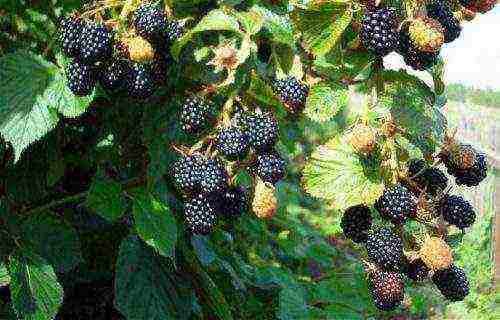
"Ruben" grows vertically, but the bush is compact and not tall (from 1.5 to 2 m). To grow it, you do not need a trellis and support. The branches are strong, do not break or bend from the wind. At the end of fruiting, the bush is cut off, so it is not gentle to take care of its insulation for the winter. In the spring, new shoots grow, which immediately give berries, ripening in August and September. The root system of the shrub is powerful, so it survives frosts easily and grows on any, even arid and not the most fertile soils.You can plant Ruben blackberries along fences and in shade. This variety also does not have thorns, besides, the berry is very easy to remove.
The berries are large (up to 10 g) and have a sweet taste. The shape is elongated, the berry is about 4 cm long. They are distinguished by good transport characteristics and a long shelf life.
Variety "Thornfree"
Differs in unpretentiousness and good adaptability to our winter weather conditions. The variety is quite fruitful, disease resistant. It can grow and bear fruit without changing the place of planting for up to 30 years.
The berries are not juicy, but "fleshy". They weigh from 7 to 9 g. They are inferior in size to some varieties, but the variety is considered commercial, since the berries have excellent taste, high storage capacity, and the berries are “one to one”. Thornfree Blackberries can be harvested mechanically. The berries ripen in August.
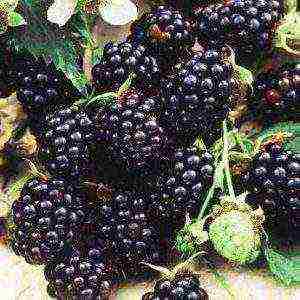 They took her out at the University of Maryland exactly half a century ago. Since then, the variety has improved so much that it has a whole list of advantages:
They took her out at the University of Maryland exactly half a century ago. Since then, the variety has improved so much that it has a whole list of advantages:
- no thorns;
- gives the harvest together;
- abundant fruiting;
- there are a lot of berries on the brush;
- taste good;
- simultaneous ripening of berries;
- does not give numerous offspring;
- is not afraid of pests and almost does not get sick;
- looks decorative and blooms beautifully.
Loch Tay variety
It was bred by the Scots, which they are very proud of, since the berries of this blackberry variety have a bright and rich taste. They are not the largest in size, weight - about 4-5 g. But all berries are uniform, marketable and transportable qualities are high.
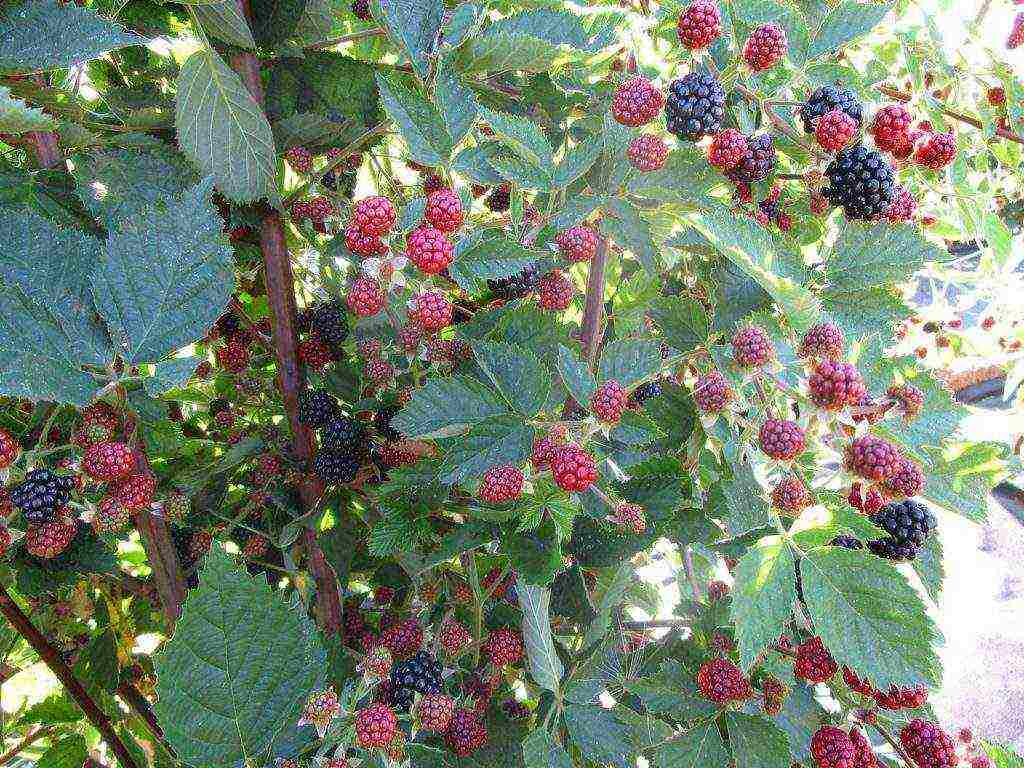
This is a tall shrub that requires installation on supports, otherwise branches with ripe brushes will fall, and the crop will be damaged.
The collection is possible mechanical, therefore the variety is classified as industrial, but it is very often grown on personal plots. The fruits ripen at the end of July.
Variety "Agavam"
This variety, bred by Americans in the second half of the 19th century, came to us half a century ago, and since then has been successfully and universally cultivated in private farms. The berries are not outstanding in size, their weight is from 4 to 5 g, but the taste is amazing, with sourness, reminiscent of wild forest blackberries.
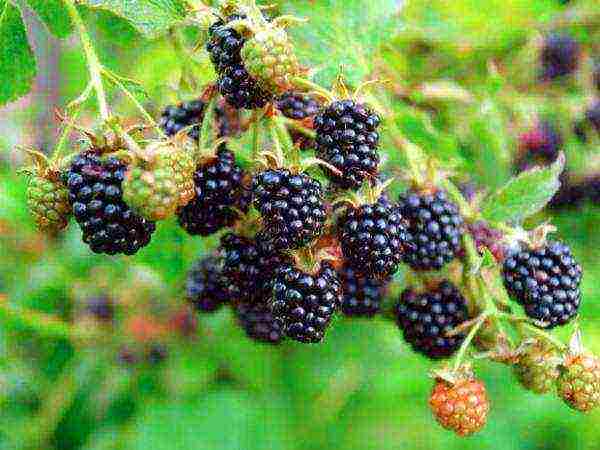
Strong vertical shoots reach 2-2.2 m. This shrub is not afraid of even the most severe frosts, it can withstand temperatures of -30 ° C.
The berries are black, shiny, as they ripen, the amount of sugar grows in them, and by the time they are harvested, they become freshly sweet, therefore, the blackberries of this variety are harvested at the stage of technical ripeness.
The variety is susceptible to numerous diseases, and if the berries are overexposed on the bush, they begin to rot. Therefore, for processing and transportation, the fruits of the Agavam variety are harvested at the end of August, without waiting for consumer ripeness, which occurs at the beginning of September.
Apache variety
 Bred in Arkansas at the very beginning of the XXI century. A tall, erect bush, up to 2.5 meters, is distinguished by enlarged berries of an interesting conical shape. 7-9 g is the average weight of fruits that can hang on the bush from mid-July to mid-August. At the same time, the quality and taste characteristics do not fall. The color remains deep black, the surface has a glossy sheen. Although the fruits are juicy, they do not wrinkle during collection and transportation.
Bred in Arkansas at the very beginning of the XXI century. A tall, erect bush, up to 2.5 meters, is distinguished by enlarged berries of an interesting conical shape. 7-9 g is the average weight of fruits that can hang on the bush from mid-July to mid-August. At the same time, the quality and taste characteristics do not fall. The color remains deep black, the surface has a glossy sheen. Although the fruits are juicy, they do not wrinkle during collection and transportation.
The taste is consistently harmonious and sweet-sour. This plant is characterized by low drought resistance and weak winter hardiness. Moreover, it does not even tolerate too dry air, therefore, it is recommended to use drip irrigation and shelter from frost for the winter.
Variety "Black Satin"
The variety, bred in the United States, strikes with powerful, fast-growing shoots that can reach up to seven meters in length. Somewhere at a height of one and a half meters, erect branches begin to creep. This is the peculiarity of this plant, which, so that the harvest does not disappear, needs a garter to a support.
The plant has no thorns and a high yield. But on the bush after ripening, the berries last for a very short time - 4-5 days.Therefore, they have to be collected in several stages, selectively, so that they do not crumble.
The berries have a rounded elongated shape, almost cylindrical, and have a pleasant taste. The variety is considered fruitful, during the wave-like fruiting season - from late July to early August, up to 16 kg of berries can be harvested from the bush.
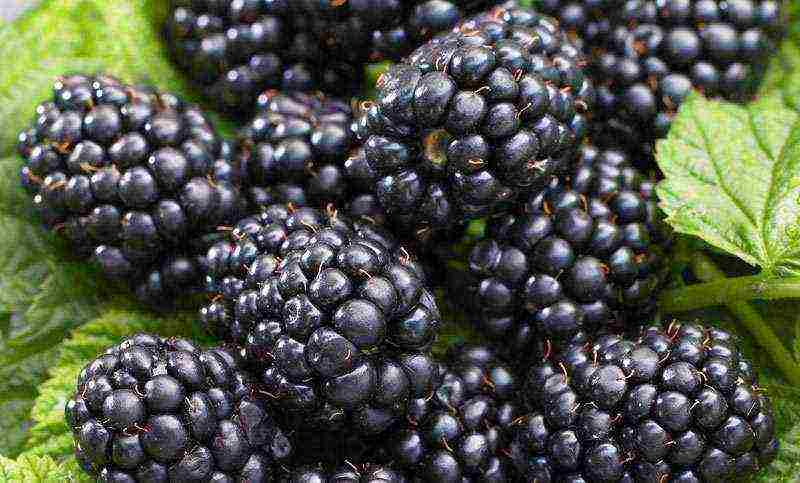
Variety "Karaka Black"
This hybrid is unique in that raspberries were involved in its selection. It was bred in New Zealand, but complex ways of multiple crossing led to the fact that a high-yielding bush with lashes up to 5 meters long, with large berries was obtained. The hybrid is distinguished by early fruiting - the first berries can be expected already at the end of June. Then, during July and until the beginning of August, the harvest of large, narrowed to the bottom and elongated glossy black berries, weighing from 8 to 10 g, ripens in waves.
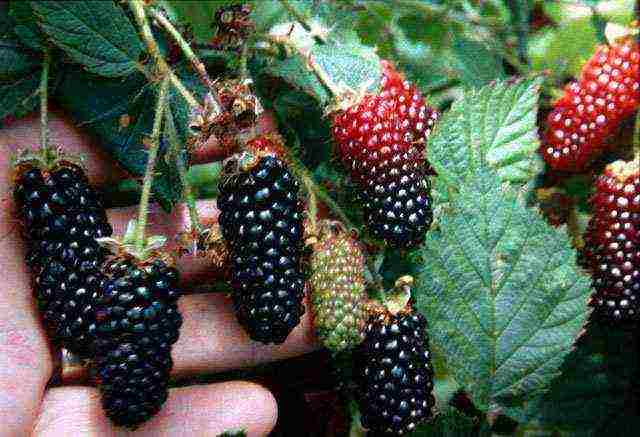
The taste and aroma are good, the fruits are suitable for storage and are not damaged in transit.
The plant is resistant to pathogens and adverse conditions, but suddenly, in the middle of the growing season, the leaves on it may turn yellow. This feature is not a pathology or a sign of any disease.
Variety "Chester Thornless"
One of the most frost-resistant varieties, bred in America in the seventies of the last century. It is characterized by frost resistance above average (withstands frost down to -26 ° C). A semi-flattened look that requires a trellis garter. The height of the whips is up to one and a half meters. The size and weight are medium and large - up to seven grams. The color is gray-black, the surface is shiny.
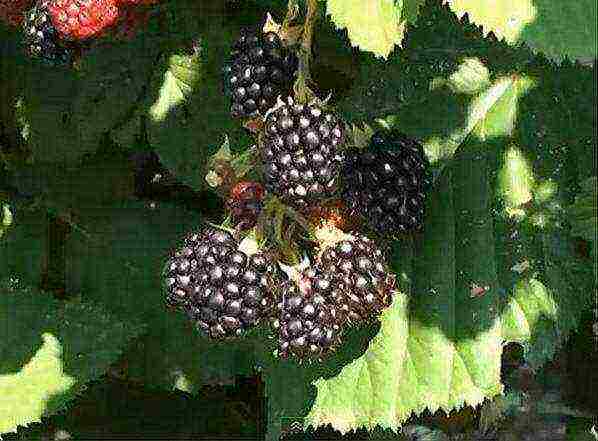
The taste is rich, sweet, almost no sourness. The structure of the berries is very dense, they are strong, even when ripe. They can be easily transported and stored for a long time without losing their presentation.
The variety has a fairly high yield - with trellis cultivation - up to 15 kg of berries from a bush. Ripen from late July to early August.
Variety "Polar"
This variety is from the "new" ones. It was bred by Polish breeders 10 years ago, but specialists have been working on its improvement for about thirty years. What happened as a result? High yield combined with unpretentiousness and minimal cost of caring for the shrub.
 Erect shoots of 2.5 meters do not require support. Glossy dark berries look neat, having the same oval shape. The taste is rich in flavor, but lacks the astringency that is inherent in many blackberry cultivars. The acid is minimal. Ripening periods are extended. Fruiting begins in July and can, under favorable weather conditions, continue until September.
Erect shoots of 2.5 meters do not require support. Glossy dark berries look neat, having the same oval shape. The taste is rich in flavor, but lacks the astringency that is inherent in many blackberry cultivars. The acid is minimal. Ripening periods are extended. Fruiting begins in July and can, under favorable weather conditions, continue until September.
The variety is resistant to pests and diseases, ideal for growing in our climate.
Blackberries are a delicious berry that can diversify the garden assortment of a summer cottage. Its yield justifies the labor costs of cultivation, and the vitamin and mineral composition is not inferior to the "healing" raspberries. If you choose the right variety, based on the capabilities of the site and the needs of the family, you can provide yourself with interesting flavor combinations in winter preparations. Many different compotes, jams, jellies, marmalades are made from blackberries, they can be preserved in their own juice, frozen and, of course, eaten fresh. Since most successful varieties have a fruiting period of about a month, it is easy to have a source of vitamins on the site when growing blackberries.
Video review: how to plant a blackberry
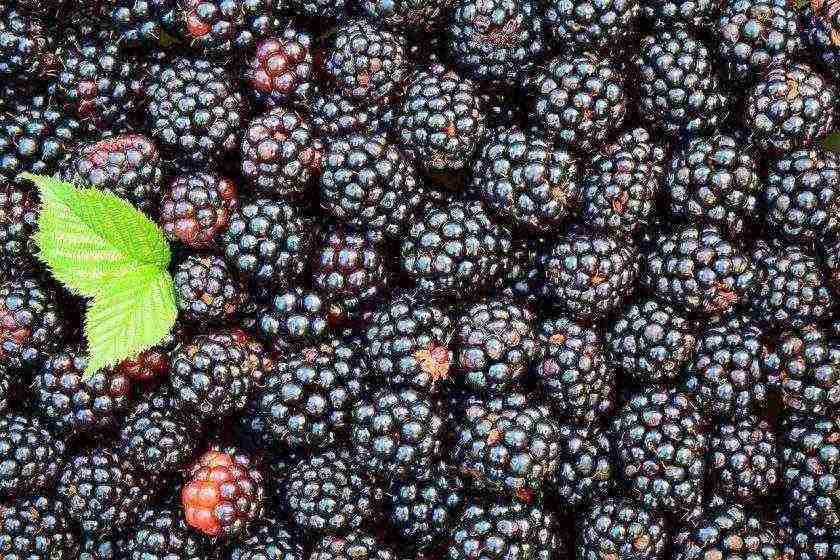
To date, about two hundred varieties of cultivated blackberry varieties have been described. Many gardeners are familiar with blackberries. And in nature it occurs quite often.
Content:
Biological features 
Forest gray blackberry - the ancestor of garden varieties and hybrids
Because of the small tenacious thorns, the blackberry thickets are practically impassable. Wild blackberries are most often found in ravines, near rivers and streams.
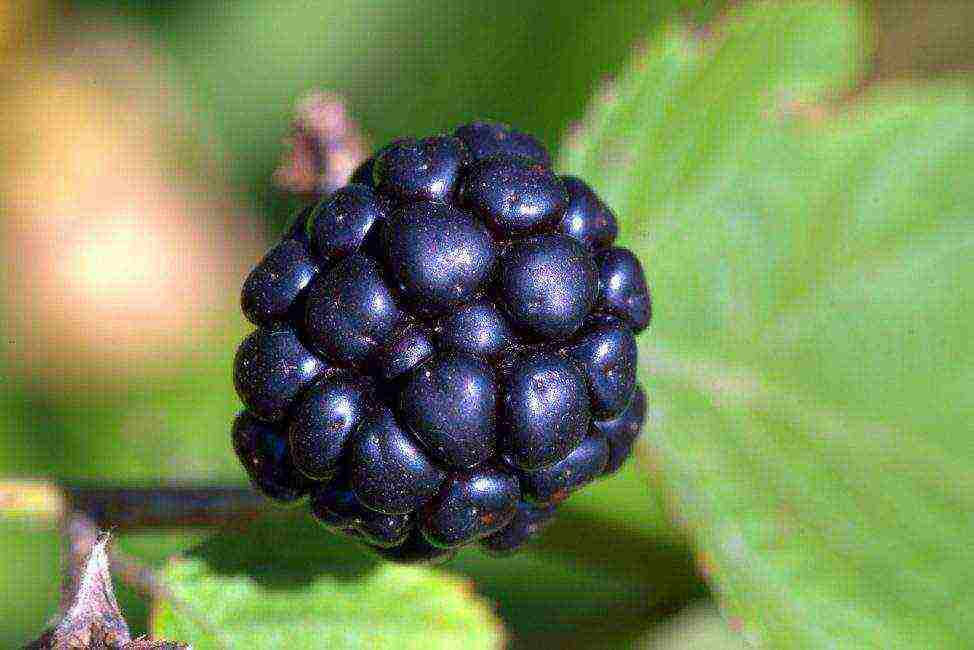
The name itself indicates that it is prickly, like a hedgehog.
back to menu ↑ Characteristics of varieties and hybrids
The cultivated form of blackberry came to the gardens of Russia from America. These plants are powerful, high-yielding, with juicy and sweeter large fruits than wild forms. Below is a description of the most popular varieties and hybrids.
back to menu ↑ Black Satin 
Black Satin
back to menu ↑ Brzezina 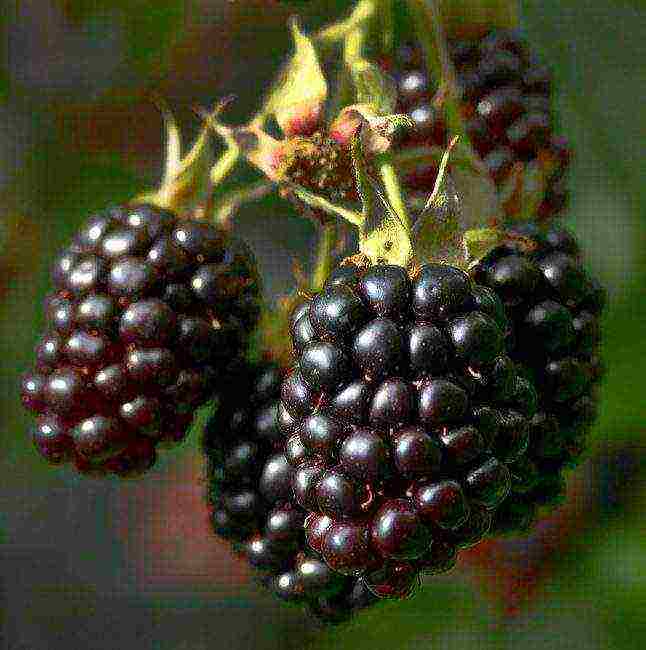
Brzezina
back to menu ↑ Natchez 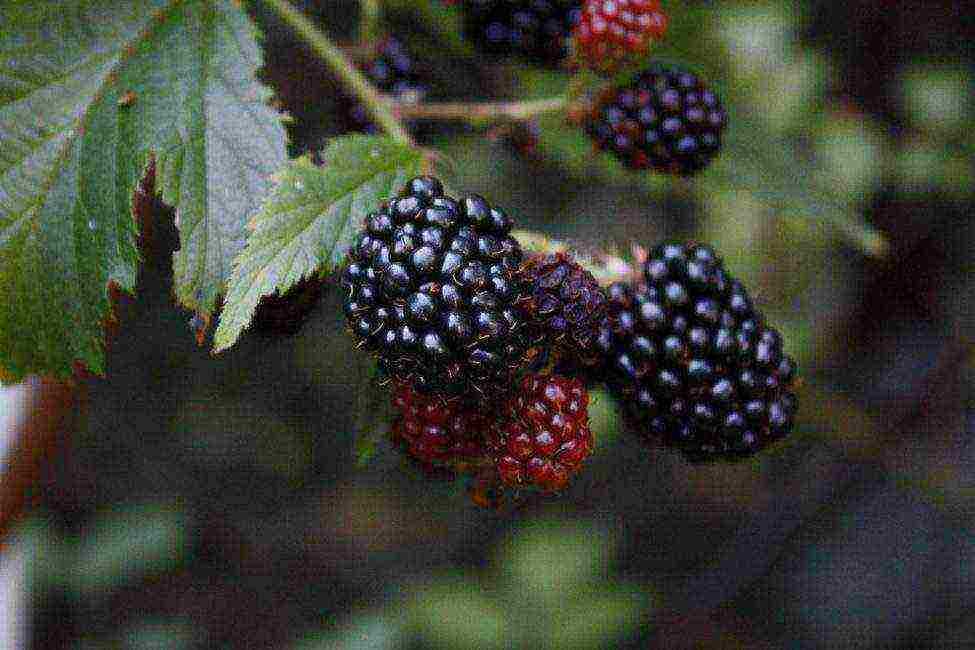
Blackberry Natchez
back to menu ↑ Karaka black 
Karaka black
back to menu ↑ Thornfree 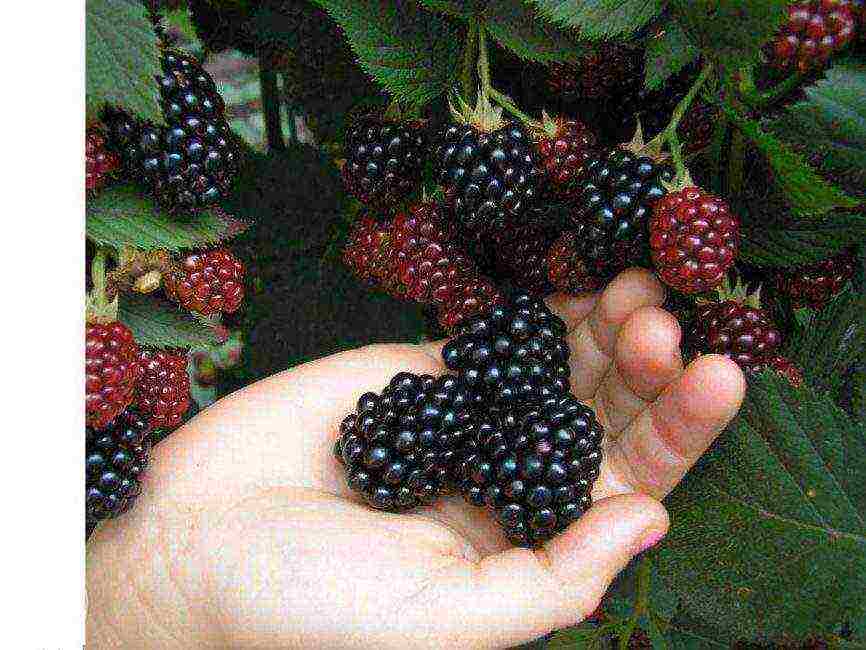
Thornfree
back to menu ↑ Chester 
Chester
back to menu ↑ Triple Crown 
Triple Crown
back to menu ↑ Agavam 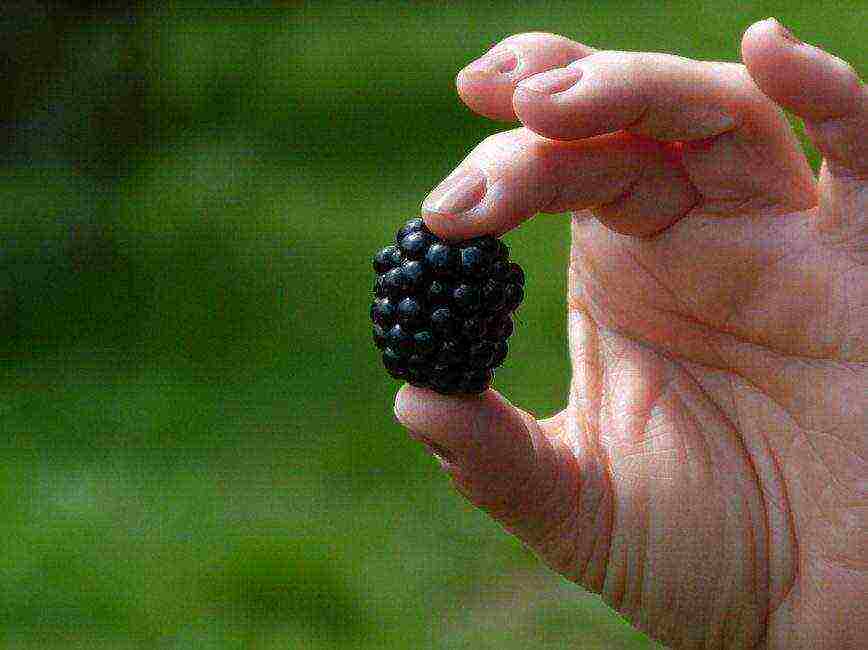
Agave
back to menu ↑ Thornless 
Thornless
back to menu ↑ Navajo 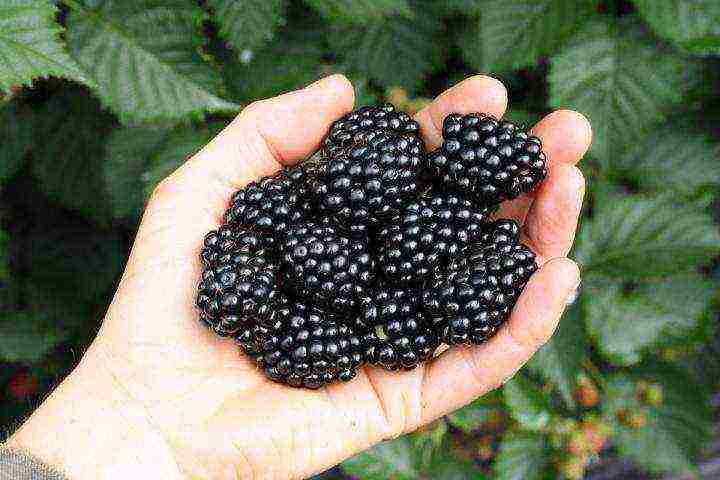
Navajo
On chernozems, organic matter can not be introduced, otherwise the bushes will begin to "fatten" and will not bring a good harvest.
back to menu ↑ Lochness 
Lochness
back to menu ↑ Polar 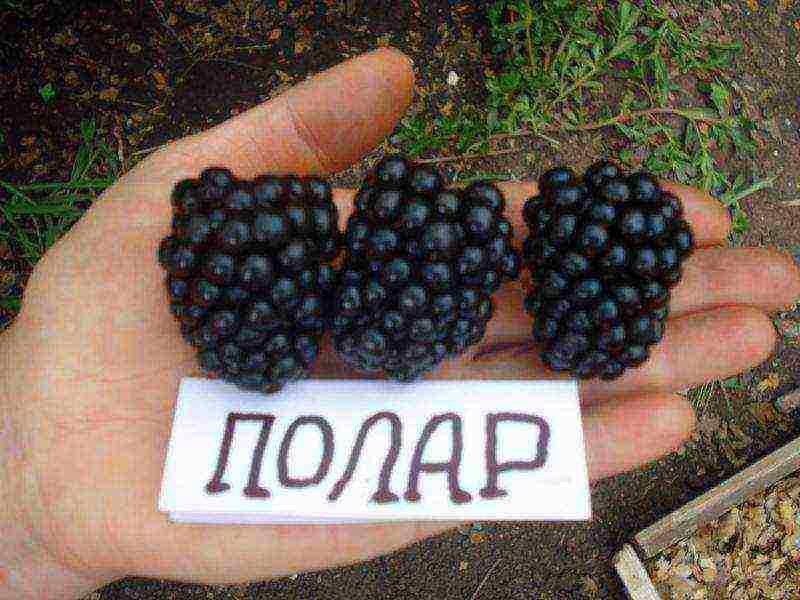
Polar
back to menu ↑ Loch tei 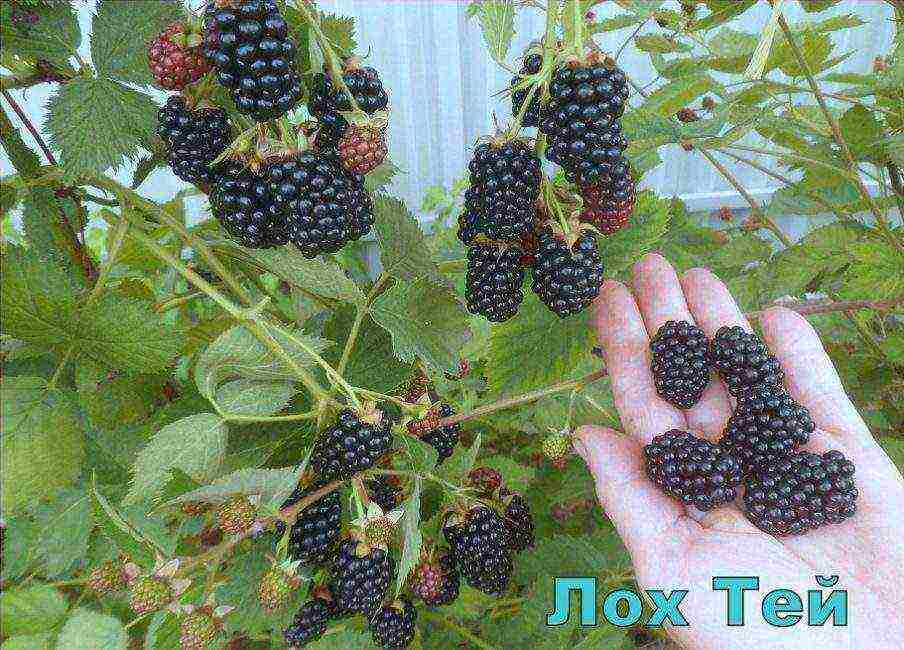
Lochtey
back to menu ↑ Jumbo 
Jumbo
back to menu ↑ Kiova 
Kiova
back to menu ↑ Ruben 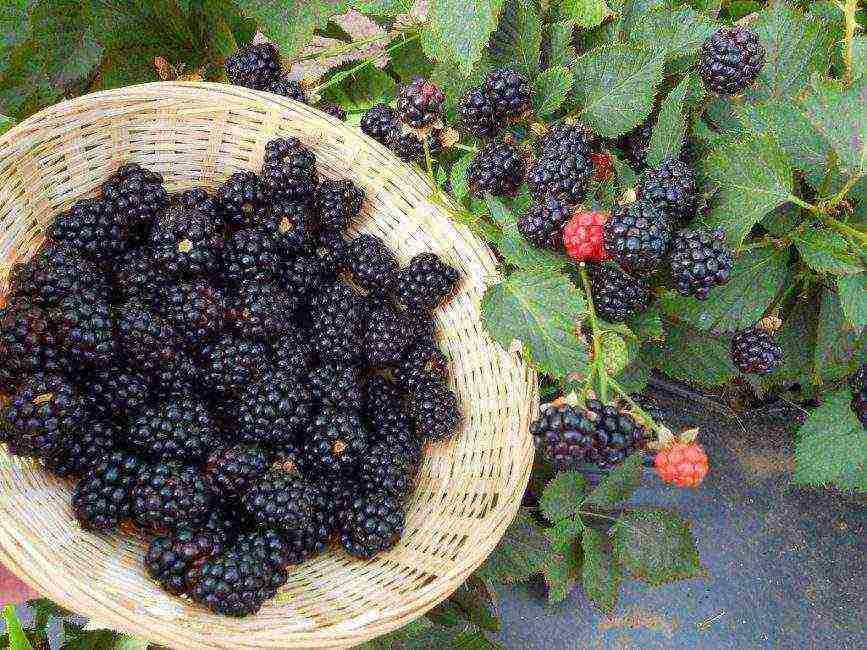
Ruben
back to menu ↑ Black Magic 
Black Magic
back to menu ↑ Growth and fruiting
The development cycle of blackberry shoots is two years old, because it is the closest relative of raspberries. The first year is devoted to shoot growth and bud formation. In the second year, the shoot bears fruit and dies off.
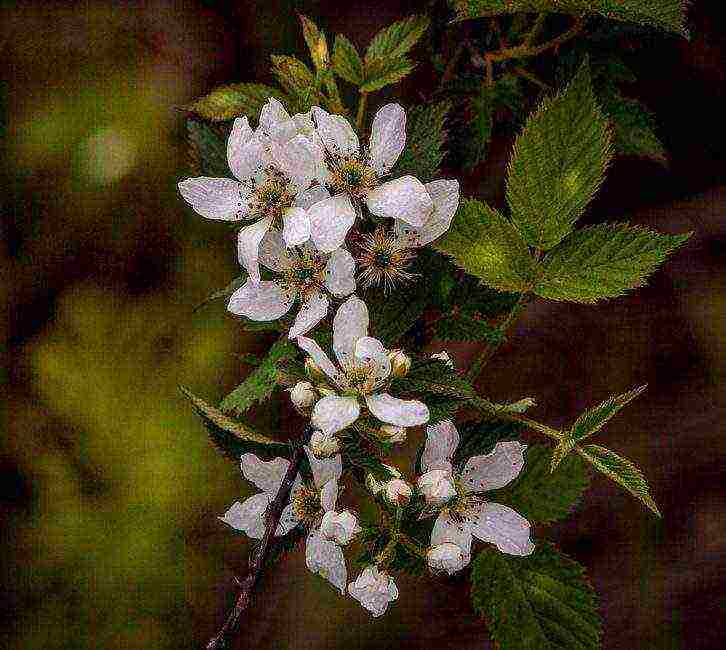
Blackberries bloom quite late, not earlier than June
Blackberries bear fruit very abundantly. The dark purple, red or black fruits are similar in shape to those of raspberries. In principle, there are two forms of blackberries - kumanik (it is she who is most often called blackberries) has erect shoots, they are creeping in dewberries.

Blackberries bear fruit very abundantly.
Transitional forms can often be found. In the garden, prickly blackberries are placed on a trellis in a single or double row planting. It is very convenient to place blackberries, for example, along a fence, near the walls of outbuildings, etc.
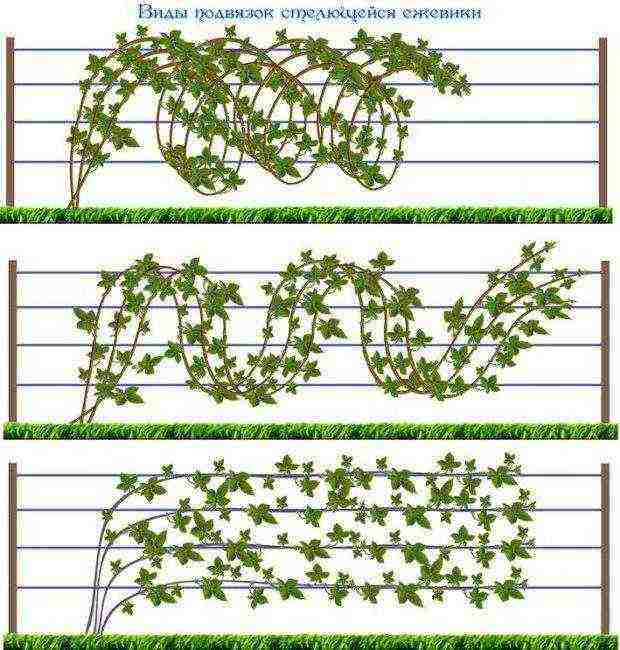
In the garden, prickly blackberries are placed on a trellis
The distance between plants is from 3/4 to 1 meter. Up to 2 meters are left between the rows. Stems of the second year (fruiting) are fixed on the upper row of wire, young ones - on the lower one.
back to menu ↑ Growing on a personal plot 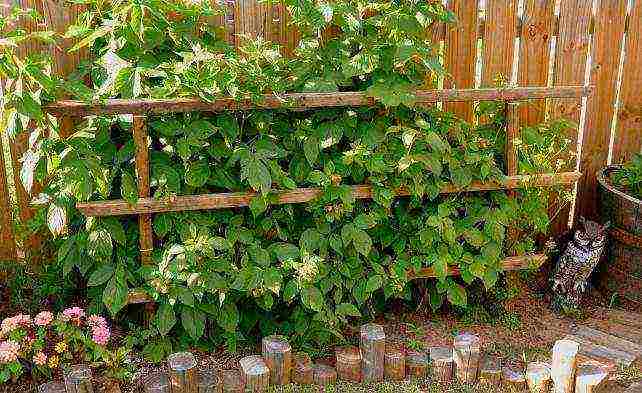
Blackberries on a trellis along the fence
- During the period of fruit emergence, cultivated blackberries are quite demanding on the presence of moisture in the ground. With its lack of berries, there are few berries, they are dry, and often crumble without ripening.
- At the same time, the plant does not tolerate waterlogging. Stagnant water is especially contraindicated for blackberries.
- For an adult bush, a sufficiently long stay on waterlogged soil may not become destructive. But the layers will almost certainly die, as their roots are ripped out.
- The plant is quite drought tolerant. This is due to deeper roots than raspberries.
- The root system can go to a depth of more than one and a half meters.
- It should be borne in mind that blackberries love the sun. It can develop in a small shade, but both the yield and the sugar content of the berries suffer greatly from this.
When planting bushes, it is necessary to ensure good drainage of the soil and an abundance of sun. The rest of the blackberry bushes are not too whimsical. But do not forget about the small but extremely tenacious spikes. Place the blackberries so that they are easy to pick.
Berries blackberries are good in any form. Jam is made from it, ground with sugar. Dried berries make an amazing tea in winter. And fresh blackberries, perhaps, are no worse than even raspberries.
back to menu ↑ Vegetative propagation
Blackberries are propagated by the tops of shoots and root cuttings.

Shoots formed from buds on an underground rhizome
- For the first method, at the beginning of August, at the end of young, this summer, shoots are buried in an upright position in the ground, where they root well during the fall.
- In the spring, the shoots are cut off and, using a sharp knife, cut out with a lump, in the form of an overturned pyramid, are transplanted into the place of new rows.
- There is also a method that is used too strongly growing varieties with standing wins, in which the root system is located more in a horizontal direction (this method is not applicable to creeping varieties, because their roots develop in a more vertical direction).
- Large, highly developed bushes are cut out of the ground with a sharp shovel and transplanted in this form.
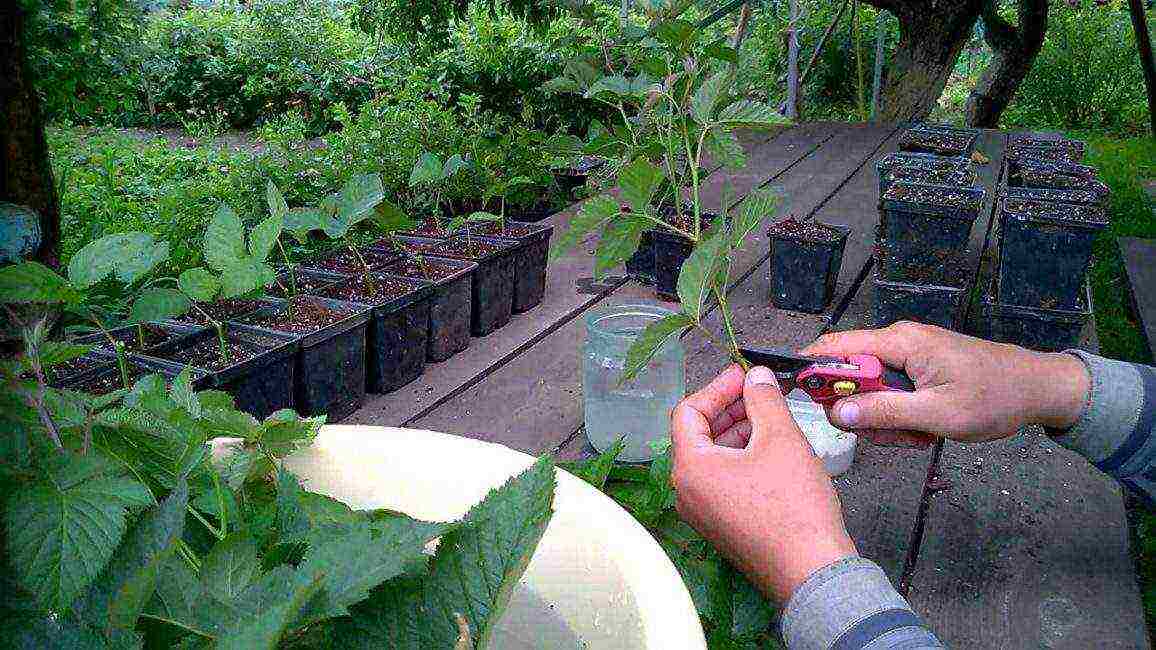
Blackberries are propagated by the tops of shoots and root cuttings
Thus, in the place where the bush was taken out, the ends of the roots remain, which in the same summer shoots and form several new independent plant specimens suitable for transplantation next spring.
back to menu ↑ Basic principles of planting care 
Blackberry bush
- The plant hibernates better when the upper part of the stems is removed. The lateral branches that appear in the spring are shortened, leaving 25-40 cm. In winter, the dewdrop must be covered.
- Closer to spring, the bushes are opened to ventilate. In a warm winter, they are constantly ventilated by opening the ends of the cover.
- With improper ventilation, frost burns of the plant and other diseases are possible.
- Erect and mixed forms are sometimes forced to creep, bending down replacement stems, which have reached a length of half a meter. Moreover, it is not worthwhile to strongly oppress the stem, over time it will bend more itself.
- Having pinned the neatly bent stem to force it to develop parallel to the ground, it is immediately pinched. This forces the side branches to actively develop. On a young shoot, all buds are flowering.
- Thus, it is possible to create a more compact bush, characterized by high productivity.
- Immediately after collecting the last berries, the old shoots are removed to enable the young to grow stronger.
- The root system lives for more than one year, it is represented by a powerful rhizome (underground stem) and additional roots that grow from underground stems.
- Basically, all roots are located in the soil up to 45 centimeters, some roots reach 90 cm and deeper. A strong root system promotes the formation of strong shoots, ensures their good growth and yield.
back to menu ↑ Plant life cycle, ability to regenerate
With age, subsequently aging, the underground part of the plant loses its ability to recover, the formation of new shoots stops and the plant dies... The plant lives as long as the underground rhizome is able to produce new replacement shoots. All representatives of blackberries have a large number of adventitious buds on additional underground rhizomes, from which stems are formed, which can be used for propagation, or left for fruiting in a row strip.
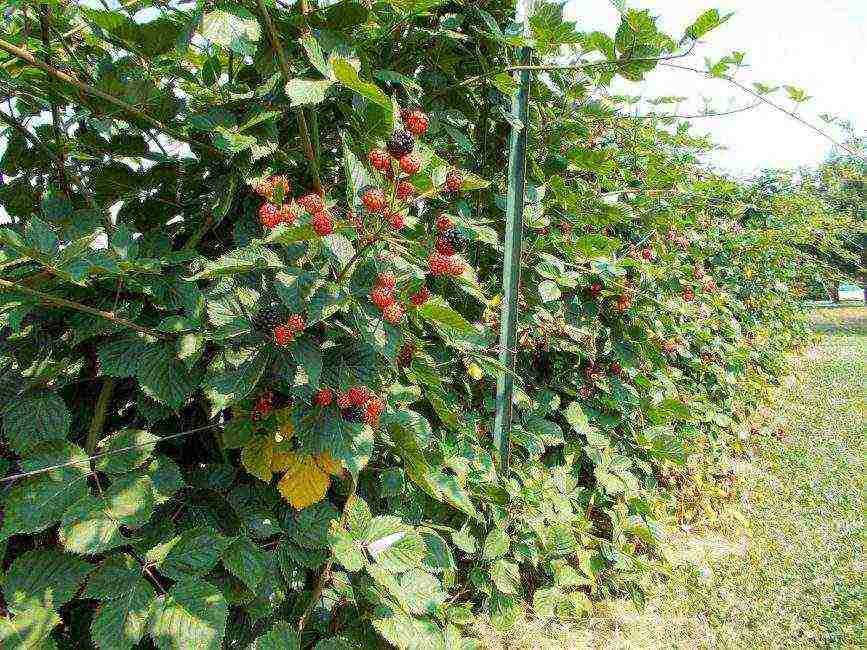
Blackberry plantations
Deeply placed old roots form few root processes. A large number of root shoots grow on light, rich soils in young plantings. Already in the third year after planting, the root shoots sprout at a distance of 100-120 cm from the bush.
- Blackberry stems have a two-year development cycle, and the underground rhizome lives for more than one year.
- Depending on the power of growth and the method of cultivation, during the first season, blackberry shoots reach 1.7 - 3.2 meters in height and practically do not branch out.
- The taller and thicker the stems grow in the current year, the higher the harvest is expected for them next season.
- Sometimes it happens that strong shoots grow too quickly due to moisture and fertilizers, such shoots do not ripen in time and freeze in winter, which negatively affects their further productivity.
- Annual spring shoots, which are most often formed from replacement buds on the underground rhizome, do not grow in height and do not thicken the next year, and fruit branches with leaves and inflorescences develop from their buds.
- After the fruits ripen, the fruiting stems gradually die off, in late autumn they become completely dry.
- This does not need to be brought up, since they use nutrients and moisture that do not benefit the next year's harvest. Therefore, after the end of the collection of berries, such stems must be removed from the plantings completely.
In the second half of summer, summer shoots grow, which have no economic value. They must be removed along with the stems that have borne this year.
back to menu ↑ Pests and diseases
- Of the various pests, which, by the way, are few in blackberries, the main place is occupied by parasitic fungi that develop in the form of rust on young shoots and leaves, and the latter are covered with grayish brown spots.
- The affected leaves dry out over time and fall off, significantly weakening the development of the plant.

Shoots damaged by a walnut fly
- Common orange rust is one of the most common types of fungal parasites.
- All such diseases can be cured by spraying with Bordeaux liquid.
- The first spraying is done before bud break; the second - when the young shoots reach a length of 15-20 centimeters, and the third - at the end of the collection of berries and removing the cutting of fruiting shoots.

Weevil on a blackberry leaf
- Among the insects, some borers are harmful and, mainly, the nut fly, which lays eggs in the peel of the shoot, from which the latter swells in the place of damage in the form of an influx;
- Such a shoot bears fruit of poor quality or often does not bear fruit and dies off. The fight against this pest consists in cutting and burning damaged shoots.
8.5 Overall Score
We have tried to collect for you the most popular blackberry varieties and give them an informative characteristic. If you disagree with these ratings, leave your rating in the comments with the reasons for your choice. Thank you for your participation. Your opinion will be useful to other users.
Relevance of information
Reliability of information
9.5
Add your review


